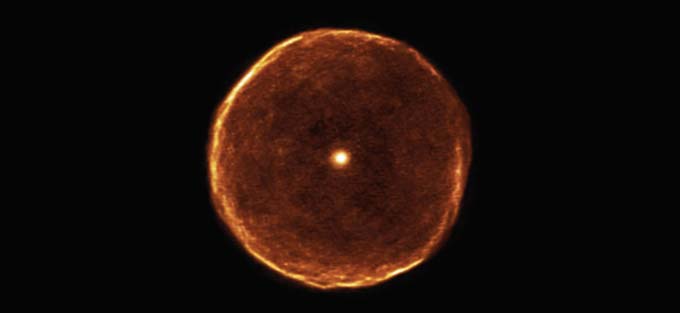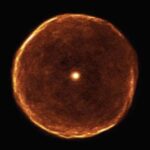ALMA captures ‘bubble-blowing star’
Read time: 3 minutes
What does this nebula look like? A soap bubble, right?
When you’re blowing soap bubbles, their outer rims are most conspicuous, even though the thin layer of soap has the same thickness everywhere. With this ALMA image, it’s the same. You’re not looking at a ring of glowing gas, but a nice, round bubble. It’s just that the outer rim is most conspicuous.
The bubble has been blown into space by the star in the center. The star is known as U Antliae. It’s a ruddy star in the southern constellation Antlia, the Air Pump. Some 2,700 years ago, U Antliae produced a big ‘puff’ that lasted for a couple of centuries. By now, the expanding shell of gas has grown to a width of one-third of a light-year (some 3 trillion kilometers).
The surprising thing about the stellar bubble is how thin and how perfectly round it is. The ALMA measurements confirmed that the gas is blowing away from the star at almost the same speed speed in every direction: 19 kilometers per second.
U Antliae is an old star that is nearing the end of its life. Now that the outer layers of the star have been blown away into space, what’s left is a so-called carbon star. In the distant future, the star will shrink into a white dwarf.
Meanwhile, the material in the shell will slowly disperse, cool down and condense into dust particles. Astronomers study ‘bubble-blowing stars’ like U Antliae to learn more about the life cycle of stars in the Universe, and about the origin of cosmic dust.
What?
U Antliae is a so-called variable star: a star whose brightness changes over time (the variable stars in a constellation are usually denoted by capital letters). The star is located at a distance of some 1,630 light-years in the southern constellation Antlia, the Air Pump. Some 2,700 years ago, U Antliae was blowing a lot of gas into space: about three times the mass of the Earth per year. The ejected gas produced a thin, round bubble with a diameter of one-third of a light-year.
Who?
The ALMA images and measurements of U Antliae and its expanding bubble of gas were obtained by a large team of astronomers, led by Franz Kerschbaum. Franz is the former director of the Institute of Astrophysics at the University of Vienna in Austria. He worked together with colleagues from Austria, Sweden, Belgium, France, Germany and South Africa.
ALMA URL
